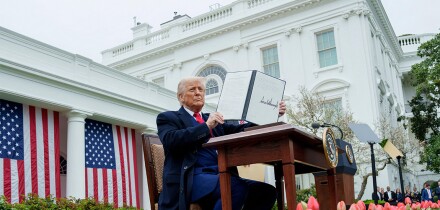Market Makers' Short Term Regime Impact

The View
Market makers in plain vanilla equity index derivatives prefer to look at implied volatilities rather than prices in order to monitor the market and set their bid/offer quotes. Typical Black-Scholes volatility curves derived from a set of option prices with different times to expiration can be found in figure 1.
Market makers offering two-way quotes willing to buy at cheap/low volatility and willing to sell at rich/high volatility view the market as in figure 2, where a simple bid and offer volatility trading band is plotted as well as market quotes.
Regimes Under A Jump In The Underlying

Two major regimes in the volatility world have been identified and analyzed by E. Derman (Regimes of Volatility Goldman Sachs, Quantitative Strategies Research Notes, Jan. 1999): sticky-strike and sticky-delta, where--in short--with the underlying moving in sticky-strike fashion the volatility tends to be fixed for a given options' contract and in sticky-delta terms it tends to be bound to the option's delta.
This shows one choice a market maker in the short-term trading environment faces when the underlying jumped: should the quotes be re-valued based on the old volatility and the new underlying level, corresponding to sticky-strike, or should a model be developed that also includes volatility changes for each contract, e. g. as in sticky-delta?
An Example
Let us now consider what happens, when the FESX suddenly drops.

Figure 3 shows instantaneous volatility moves in which market participants apply different models. The lines follow sticky-strike and single market quotes all exhibit sticky-delta characteristics. With a drop in the underlying, the market quotes move to the left as indicated. When these two models meet in the market one of them views volatility at four strikes as cheap, the other thinks its rich and they enter trades as indicated in figure 3. All this happens within a blink of an eye as machines are used to spot trade opportunities.
Both puts and calls (calls not plotted here) tend to have the smallest bid/ask volatility spreads when they are slightly out of the money. Thus induced by the regime dependent volatility moves, one market participant will sell calls and buy puts and the other swill do the opposite.
One market participant will sell calls and buy puts, the other will do the opposite even though both are being driven by the same volatility moves. Also, both may meet again in the underlying market looking for the delta hedge.
Which strategy leads to profit is hard to say, that's probably why mass quoters tend to take their quotes out of the market as soon as the underlying moves fast. Others try to get an edge by hiring quantitative skills and servicing huge amounts of market data--lots of that is available on electronic exchanges.
This week's Learning Curve was written by Erwin Pier-Ribbert, executive partner at Arbex Concord Derivatives.






